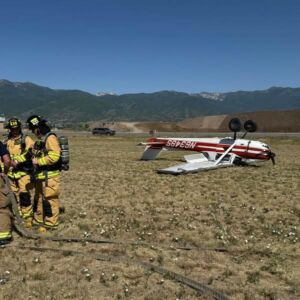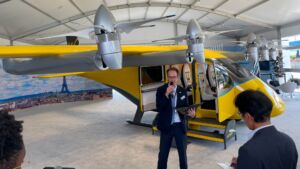Here are your stories for today...
Be safe out there!
Tom
Navy plane makes emergency landing at Pensacola International Airport
by WEAR staff
PENSACOLA, Fla. -- Two Navy pilots assigned to Training Air Wing 5 were transported to medical facilities out of precaution following an emergency landing at the Pensacola International Airport Tuesday afternoon.
to Training Air Wing 5 were transported to medical facilities out of precaution following an emergency landing at the Pensacola International Airport Tuesday afternoon.
The landing happened around 1 p.m.
According to the Navy, two pilots assigned to Training Air Wing 5 were diverted to Pensacola International Airport due to weather in the area.
"Preliminary reports indicate the aircraft experienced a mishap upon landing," the Navy tells WEAR News. "Out of precaution, both aviators were transported to local medical facilities to be evaluated."
The Navy says the cause of the incident remains under investigation.
The airport was temporarily closed but has since reopened.
https://weartv.com/news/local/navy-plane-makes-emergency-landing-at-pensacola-international-airport
Pilot walks away from small plane crash in Heber City with minor injuries
HEBER CITY, Utah (ABC4) — A pilot received minor injuries after a small aircraft crash during a training session Tuesday morning.
minor injuries after a small aircraft crash during a training session Tuesday morning.
According to a press release from the Heber City Police Department, just before 11 a.m. this morning, they responded to a small aircraft crash with the Wasatch Fire District at the Heber City Airport.
The caller who reported the emergency to police said that a plane had “flipped onto its top during a landing attempt,” police say. According to FAA Registry records, the aircraft is a Cessna 150G.
When emergency personnel arrived, the pilot was already outside of the aircraft and “alert and walking,” according to police. The pilot was the sole occupant and only sustained some minor cuts and abrasions.
According to the press release, the pilot told police that the crash happened during a practice session for grass landings. As he was performing one of these practice landings, the aircraft “overturned and came to rest upside down.”
police that the crash happened during a practice session for grass landings. As he was performing one of these practice landings, the aircraft “overturned and came to rest upside down.”
Heber City Police Department credits the “swift response and coordination of Heber City Airport personnel” for righting and securing the small aircraft.
5 hurt in crash involving shuttle bus leaving Denver International Airport
By Jennifer McRae
Five people were hurt in a crash involving a shuttle bus leaving Denver International Airport on Tuesday morning. Denver police told CBS News Colorado that a Chevy Malibu and the bus collided, causing the bus to flip over on its side.
shuttle bus leaving Denver International Airport on Tuesday morning. Denver police told CBS News Colorado that a Chevy Malibu and the bus collided, causing the bus to flip over on its side.
Investigators believe the crash was caused by one of the drivers crossing the center line but are trying to determine which one.
The crash happened on airport property on Jackson Gap Street near East 71st Avenue. Police said a first responder witnessed the crash.
"A Denver paramedic on her way to work was two cars behind; she saw the collision, but was unable to determine who crossed the double yellow line," said Denver Police Lt. Todd Fuller.
Police confirmed one of the people injured in the crash is the driver of the Chevy Malibu.
https://www.cbsnews.com/colorado/news/5-hurt-crash-involving-shuttle-bus-denver-international-airport/
Wisk Aero Plans to Fly Electric Air Taxi in Miami, Japan
Miami-Dade Aviation Department will work self-flying air taxis into its existing planning for airports, airspace management, and infrastructure, Wisk says.
Jack Daleo
PARIS—Wisk Aero, the electric vertical takeoff and landing (eVTOL) arm of Boeing, is eyeing Miami and Kaga City, Japan, as some of the first markets for its self-flying air taxi.
takeoff and landing (eVTOL) arm of Boeing, is eyeing Miami and Kaga City, Japan, as some of the first markets for its self-flying air taxi.
At the Paris Air Show on Monday, Wisk announced a flurry of new agreements with the Miami-Dade Aviation Department (MDAD) and University of Miami’s Engineering Autonomy Mobility Initiative (MEAMI), as well as the city of Kaga and Japan Air Lines Engineering Co. (JALEC). The collaborations are intended to prepare those markets for the introduction of Wisk’s Generation 6 air taxi.
The Boeing subsidiary aims to fly paying customers before the end of the decade. Becky Tanner, chief marketing officer of Wisk, told reporters at the air show that the service will likely come at a variable cost to customers, similar to Uber’s use of surge pricing during rush periods. But Tanner emphasized that it will be “accessible” and not simply a service for the wealthy, as some critics have contended.
The four-passenger Gen 6 flies autonomously and is supervised by ground personnel, who can take control as needed. It has a 72 nm range with reserves and 110-120 knots cruise speed, making it suitable for short-hop flights. Its ability to take off vertically eliminates the need for a runway, opening up operations in urban hubs. Wisk hopes, for example, to ferry passengers around the 2032 Olympic Games in Brisbane, Australia.
The company in 2024 revealed its first U.S. operational plans: a network connecting the Greater Houston area with operations based in Sugar Land, Texas, where it is working with the city to set the stage for the Gen 6. The company will explore adding a vertiport—an electrified takeoff and landing hub—to Sugar Land Regional Airport (KSGR), which manages about 75,000 operations per year.
Wisk has similar plans for Miami. It and MDAD are eyeing Miami International Airport (KMIA), Miami Executive Airport (KTMB), and Opa-locka Executive Airport (KOPF) as potential vertiport sites. Wisk will provide “technical guidance” for the electrified hubs, as well as other infrastructure and flight procedures. MDAD, meanwhile, is baking self-flying air taxis into its airport development and airspace management efforts. Wisk CEO Sebastien Vigneron told reporters the partnership will further explore air taxi routes.
University of Miami researchers will also have a role to play, with plans to study self-flying technology, operations, regulations, safety, and business opportunities in the U.S. Wisk will gain access to the school’s resources and facilities, and it plans to apply for grants for joint projects.
On the other side of the world, Wisk is firming up its partnership with Japan Air Lines, with which it is researching air taxi certification, maintenance, overhaul, and airspace integration. The carrier’s engineering subsidiary will tackle integration from the perspective of regulations. Beyond that, it will conduct an analysis of markets, supply chains, manufacturing, and social acceptance of autonomous flight in Japan.
Compared to Miami or Houston, Kaga’s population of about 62,000 people is small. But the Japanese government has designated it a national strategic special zone, which according to Kaga City mayor Riku Miyamoto gives it more flexibility to study the technology compared to large cities such as Tokyo or Osaka.
“Because the city has been selected as a national strategic special zone, we are able to carry out bold regulatory development in Japan,” Miyamoto said in remarks accompanying the announcement. “There is a high degree of freedom as a research and development field, and one-stop arrangements are possible.”
national strategic special zone, we are able to carry out bold regulatory development in Japan,” Miyamoto said in remarks accompanying the announcement. “There is a high degree of freedom as a research and development field, and one-stop arrangements are possible.”
The pair of landmark agreements come as Wisk looks to ramp up flight testing. Dan Dalton, Wisk’s vice president of global partnerships, said it is eager to explore the eVTOL Integration Pilot Project (eIPP) created by a White House directive last week. That effort is expected to comprise five trials across three years.
The company’s Gen 6 preproduction prototype has yet to fly. But Vigneron said the vehicle is wrapping up ground testing and “almost ready” to hit the skies. He added that the company is building a second flight test vehicle to further expand the test campaign.
The FAA expects to certify autonomous air taxis after the Gen 6’s piloted competitors—such as Archer Aviation’s Midnight and Joby Aviation’s S4—begin flying. The challenge is one facing regulators worldwide.
China, for example, in April approved passenger carrying operations for EHang’s EH216-S—the first autonomous aircraft in the world to reach that milestone. But EHang’s early operations will be restricted to operations like out-and-back sightseeing flights. Its routes must be private, trips nonscheduled, and tickets sold directly rather than through a charter service. Those limitations preclude the company from launching a full-fledged air taxi service.
https://www.flyingmag.com/wisk-aero-plans-to-fly-electric-air-taxi-in-miami-japan/?oly_enc_id=3681J3205156A2X
NTSB Prelim: North American T-28B
Pilot Started To Return To The Airport Before Electing To Land On A Nearby Dirt Road
Location: Olivehurst, CA Accident Number: WPR25LA159
Date & Time: May 17, 2025, 10:22 Local Registration: N28DE
Aircraft: North American T-28B Injuries: 2 Serious
Flight Conducted Under: Part 91: General aviation - Personal
On May 17, 2025, at 1022 Pacific daylight time, a North American T-28B, N28DE, was substantially damaged when it was involved in an accident near Marysville, California. The pilot and passenger were seriously injured. The airplane was operated as a Title 14 Code of Federal Regulations Part 91 personal flight.
According to the operator, the airplane departed Yuba County Airport (MYV), Olivehurst, California, to perform a flyover at MYV for their organization. During the flight the engine began surging. The pilot started to return to the airport before electing to land on a nearby dirt road. During landing a wing struck a berm and spun the airplane around, substantially damaging the wings and fuselage.
The wreckage was retained for examination.
FMI: www.ntsb.gov

Today in History
53 Years ago today: On 18 June 1972 British European Airways flight 548, a Hawker Siddeley HS-121 Trident, crashed following a loss of control near Staines, United Kingdom shortly after takeoff from London-Heathrow Airport, killing all 118 occupants.
| Date: | Sunday 18 June 1972 |
| Time: | 17:11 |
| Type: | Hawker Siddeley HS-121 Trident 1C |
| Owner/operator: | British European Airways - BEA |
| Registration: | G-ARPI |
| MSN: | 2109 |
| Year of manufacture: | 1964 |
| Fatalities: | Fatalities: 118 / Occupants: 118 |
| Other fatalities: | 0 |
| Aircraft damage: | Destroyed, written off |
| Category: | Accident |
| Location: | near Staines - United Kingdom |
| Phase: | Initial climb |
| Nature: | Passenger - Scheduled |
| Departure airport: | London-Heathrow Airport (LHR/EGLL) |
| Destination airport: | Brussel-Zaventem Airport (BRU/EBBR) |
| Investigating agency: | AIB |
| Confidence Rating: | Accident investigation report completed and information captured |
Narrative:
British European Airways flight 548, a Hawker Siddeley HS-121 Trident, crashed following a loss of control near Staines, United Kingdom shortly after takeoff from London-Heathrow Airport, killing all 118 occupants.
Flight BE548 was a scheduled passenger service from London to Brussels. Start-up clearance was given at 15:39 for a scheduled departure time of 15:45. Push-back was not requested until 16:00 due to load re-adjustment. Clearance to taxi was given at 16:03. The HS-121 Trident taxied to runway 28R for takeoff. At 16:06:53 the crew reported ready for takeoff. Takeoff clearance was given and at 16:08:30 the brakes were released.
The standard BEA practice for this particular flight involved a takeoff with 20° flap, leading edge droop (wing leading edge slats) extended and the engine thrust at settings below full power. After takeoff speed should be increased to the initial climb speed VNA (ie, takeoff safety speed, V2 plus 25 knots). The scheduled value of VNA for this flight was 177 knots Indicated Air Speed (IAS). At 90 seconds from brakes-off flaps are to be selected fully up and the engine thrust reduced to the noise abatement settings. At 3,000 feet climb power is to be set and then as the aircraft accelerates and reaches 225 knots the leading edge is retracted and the en route climb established. The minimum droop retraction speed is placarded by the lever and is well-known to all pilots.
The takeoff was normal and at 42 seconds the aircraft rotated, leaving the runway 2 seconds later at 145 knots IAS. At 63 seconds the autopilot was engaged 355 feet above the runway at 170 knots IAS; the IAS speed lock was selected shortly thereafter. At 74 seconds the aircraft started a 20° banked turn to port towards the Epsom Non-Directional Beacon (NDB). At 83 seconds the captain reported 'Climbing as cleared'. He was then instructed to change frequency and contact London Air Traffic Control Centre.
At 93 seconds the noise-abatement procedure was initiated. On the assumption that the captain was the handling pilot, this would involve the second officer selecting the flaps fully up and operating the thrust levers to reduce power to the pre-calculated figure. At 100 seconds the captain called 'Passing 1500' and at 103 seconds the aircraft was cleared to climb to Flight Level 60. This message was acknowledged by the captain at 108 seconds with the terse call 'up to 60'. This was the last message received from the flight.
At second 114 when the airspeed was 162 knots and the altitude 1,772 feet, the droop lever was selected up putting the aircraft into the area of the stall as the droop started to move. At second 116 the stick-pusher stall recovery device operated, causing the autopilot automatically to disengage and the nose of the aircraft to pitch down and the stick-push to cease as the incidence decreased. Since the elevator trim would stay at its position on autopilot disengagement which at that speed with the droop up would be - the incidence then increased causing a second stick-push at second 124 and a third at second 127. At second 128 the stall recovery system was manually inhibited by pulling the lever. The aircraft then pitched up rapidly, losing speed and height, entering very soon afterwards the true aerodynamic stall and then a deep stall from which at that height no recovery was possible. Impact was at second 150 in a field next to the A30 motorway .
PROBABLE CAUSE: Immediate causes were:
1) Failure by PIC to achieve and maintain adequate speed after noise-abatement procedures; 2) Droop-retraction 60kts below minimum speed.; 3) Failure to monitor speed error and to observe droop lever movement.; 3) Failure to diagnose reason for stick-pusher operation and warnings; 4) Operation of stall recovery override lever.
A factors was a.o. the abnormal heart condition of the captain.
